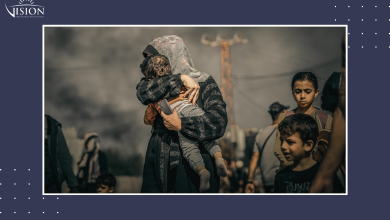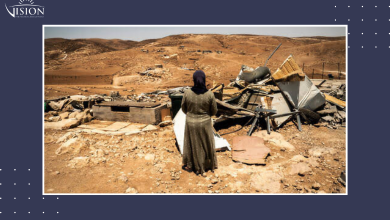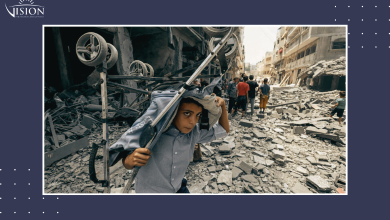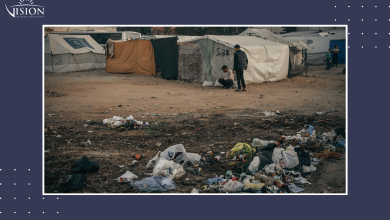A Shard of Hell: Documenting the Relentless Tragedy of Displacement in the Gaza Strip
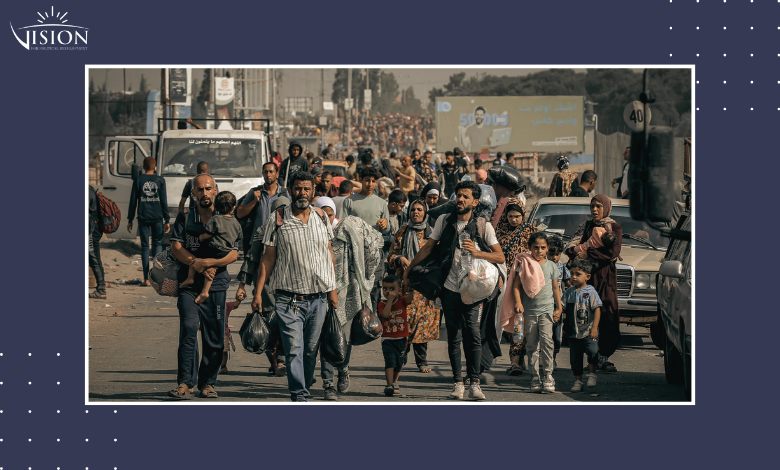
Forced displacement in the Gaza Strip is not a by-product of war; rather it is a central weapon deliberately deployed by the Israeli occupation, an instrument designed to dismantle the fabric of Palestinian society and uproot its people from their ancestral abode.
Since October 7, 2023, more than two million Palestinians have been driven from their homes under relentless barrages of airstrikes and tank shells, forced to seek shelter in shattered school buildings, makeshift tents, or public squares unfit for human life. This ordeal goes far beyond the simple loss of shelter, striking at the very core of human dignity, and has been described by countless displaced Palestinians as nothing short of “a piece of hell.”
The human suffering caused by forced displacement constitutes a flagrant violation of international humanitarian law. Article 49 of the Fourth Geneva Convention explicitly prohibits the forcible transfer of civilian populations, while the deprivation of shelter, food, and medicine is defined as a war crime under the Rome Statute of the International Criminal Court.
This report examines the machinery of forced displacement in the Gaza Strip by tracing its stages, underlying causes, and devastating human, social, and economic dimensions, culminating in the catastrophic consequences it has inflicted upon Palestinian society.
Stages of Displacement
Nearly two million Palestinians in the Gaza Strip have been displaced more than ten times since October 7, 2023, in a relentless cycle marked by repetition and escalation. What began as sudden flight soon turned into repeated expulsions and has now hardened into chronic displacement that continues to this day.
In the first phase, at the onset of military operations, the Israeli army issued sweeping evacuation orders for residents of Gaza City and the northern Strip. This forced hundreds of thousands southward into areas utterly unprepared to accommodate them. Human Rights Watch documented how these evacuation orders were accompanied by large-scale bombardment that devastated basic infrastructure, transforming displacement into a systematic tool for depopulating Palestinian-populated areas.
By December 2023, the scope of the assault expanded to Khan Younis, compelling tens of thousands of families to flee once again—this time toward Rafah in the south, which rapidly morphed into a massive encampment housing over one million displaced people.
According to United Nations reports (OCHA), by this stage more than 80% of the Strip’s population had been uprooted, with hundreds of thousands crammed into suffocatingly narrow areas along the Egyptian border.
Between March and May 2024, Rafah became a temporary refuge for displaced families, squeezed into tightly packed tents under unbearable living conditions. A black market emerged as a grim survival mechanism. Yet this precarious refuge did not last long: relentless bombardment between June and September 2024 drove people into yet another forced migration, this time toward so-called “humanitarian zones” west of Khan Younis and parts of Deir al-Balah.
Forensic Architecture described these zones as part of a strategy of “humanitarian violence,” in which evacuation orders and designated “safe areas” are weaponized to forcibly redirect population flows under military pressure.
From October 2024 to March 2025, families were shuttled back and forth between Rafah, Khan Younis, and Deir al-Balah, in a pattern of repeated displacement that rendered stability impossible. As Sharif Samour, a Gaza resident, testified: “This is the twenty-fifth displacement since the war began. I have moved from east to west, north to south, each time leaving a place I believed would be safer.”[i] His words encapsulate the unending pain and suffering of coerced migrations.
By the spring of 2025, displacement had hardened into a chronic and permanent condition, with families trapped in a cycle of coerced displacement, their lives defined by ceaseless forced movement amidst the siege and constant bombardment, with nowhere left to call home.
Scale and Causes of Displacement
Since the onset of Israel’s genocidal onslaught against the Gaza Strip on October 7, 2023, the occupation army has issued hundreds of evacuation orders that have driven some two million Gazans[ii], nearly 90% of the Strip’s entire population, into forced displacement inside Gaza. According to United Nations reports, families have been uprooted more than ten times on average, with over 1.9 million people still displaced by mid-2025.
With each new wave of evacuation orders in 2025, the velocity of displacement has intensified. Within mere weeks, hundreds of thousands of forced “movements” were recorded across the Strip, while the sight of families sleeping in the streets or under makeshift tents became a brutal fixture of everyday life.
This massive, sweeping displacement cannot be understood as incidental fallout; it follows a calculated pattern that combines systematic evacuation orders, the expansion of military operations, and the deliberate destruction of Gaza’s urban lifelines.
Human Rights Watch has documented that these orders were never temporary security measures, but rather a policy designed to drive civilians from one zone to another. UNOSAT’s satellite analysis further demonstrates the relentless rise in destroyed or severely damaged buildings, turning entire neighbourhoods into uninhabitable wastelands and rendering survival in them a literal existential risk.
Simultaneously, vital services and relief channels; water, electricity, healthcare, food, have collapsed. Overcrowded UNRWA schools and facilities, hastily converted into shelters, now barely meet the minimum threshold of survival, forcing countless families into repeated cycles of flight in search of the bare essentials of life.
The cumulative effect of evacuation orders, bombardment, urban devastation, and the collapse of services explains why displacement in Gaza has become not a one-time flight but a perpetual, grinding movement with no end in sight.
According to UNRWA, more than 330 schools and educational facilities have been turned into overcrowded shelters, a stark measure of the catastrophe confronting the displaced on a daily basis.
Behind these hard statistics lie human faces etched with exhaustion and despair. Sharif Samour from Sheikh Radwan recounts his twenty-fifth displacement since the war began: “I have moved from east Gaza to west, from north to south. Each time I believe I’ve found a quieter place, the bombing resumes and forces us to flee once more.”[iii]
Asma Hamada from the al-Karama neighbourhood describes how her family fled under a hail of rockets that “targeted everything around us.”[iv] Struck in the neck by a large stone as she ran, she later discovered that the place she reached lacked water, medicine, and safe shelter. Such testimonies are not mere footnotes to statistics; they expose the mechanics of forced displacement itself: evacuation orders that slam doors shut behind people, destruction that razes what remains of homes and infrastructure, and services eroded to the point where leaving, not staying, becomes the only possible means of survival.[v]
Humanitarian and Social Dimensions
This recurrent displacement has scarred not only Gaza’s geography and demography, but has also unleashed a multidimensional humanitarian crisis that has devastated health, education, and the very social fabric of Palestinian life. For civilians, survival has been reduced to a daily battle.
The humanitarian collapse has been most brutally visible in the health sector. Overcrowding in improvised shelters and repurposed schools has triggered widespread outbreaks of infectious diseases. Reports from the UN Office for the Coordination of Humanitarian Affairs (OCHA) and the World Health Organization have documented thousands of cases of hepatitis, acute diarrhoea, and respiratory infections, while the Palestinian Ministry of Health has registered an unprecedented surge in diseases once rare before the war, such as acute flaccid paralysis.
The closure of border crossings and the ban on medical supplies since March 2025 have only deepened the crisis, depriving patients of essential treatment. The acute shortage of medicines has become yet another form of collective punishment.
Field testimonies from Rafah and Khan Younis describe how securing a single dose of antibiotics often requires days of waiting—or turning to the black market, where prices are several times higher. This structural deprivation explains the alarming rise in mortality rates among children and the elderly inside temporary camps.
The collapse has extended beyond health into education. According to UNRWA, nearly 90% of Gaza’s schools have been destroyed or severely damaged, while the remainder have been converted into overcrowded shelters. As a result, hundreds of thousands of students have been excluded from education for a third consecutive year.
The testimony of ten-year-old Maria al-Sharif lays bare the tragedy: she has been displaced with her family more than twenty times. Each time she joined a small local learning initiative, she was forced to flee again under bombardment, never able to complete a single phase. Her story encapsulates the condition of an entire generation: suspended in perpetual dislocation, unable to move forward in their studies or imagine a stable future.
The damage runs even deeper, corroding Gaza’s psychological and social foundations. Reports from UNRWA and international medical organizations show sharp increases in depression and post-traumatic stress disorder among the displaced, while local institutions have documented a spike in domestic violence and suicides.
Psychologist Sabrine al-Sha’er, in a field interview, warned that an entire generation of children and adolescents is living through an existential psychological rupture that will cast a long shadow over their educational and social futures.
This grim reality is underscored by the words of Ismail al-Thawabta, Director-General of the Government Media Office in Gaza, who emphasized in a special interview that: “The occupation’s policies of starving people, blocking medicine, and depriving them of the most basic conditions of life amount to collective punishment in violation of Article 33 of the Fourth Geneva Convention. The use of starvation as a weapon of war constitutes a war crime under the Rome Statute.”[vi]
Such characterization places Gaza’s plight firmly within the framework of international law: not as a humanitarian tragedy alone, but as a deliberate, systematic, and legally defined war crime.
Economic Dimensions
Just as forced displacement has ravaged health, education, and the psychological foundations of society, it has also left a devastating imprint on Gaza’s local economy. Repeated waves of displacement, coupled with the destruction of residential neighbourhoods and critical infrastructure, have obliterated the livelihoods of tens of thousands of families. Shops have been reduced to rubble, farms and workshops dismantled, and educational and medical institutions, once integral to the economic cycle have been forced into paralysis. According to UN estimates, Gaza’s GDP has contracted by more than 80% in a single year, while unemployment has skyrocketed to unprecedented levels above 83%, a collapse also confirmed by World Bank reports.
Dependence on humanitarian aid has become near total. UNRWA estimates that more than 95% of Gaza’s population now relies on daily food assistance, even as the agency itself reels from crippling funding shortages. These conditions have spawned a sprawling black market, where basic goods are sold at extortionate prices, often monopolized by war profiteers and smugglers. Testimonies from displaced families in Rafah and Deir al-Balah recount how a single can of infant formula can cost the equivalent of half a monthly salary, while a mere litre of fuel has become a rare luxury. Such realities reflect nothing less than the complete breakdown of the economic cycle.
Economist Ahmad Abu Qamar captured the essence of this collapse in a special interview: “The economy in Gaza has shifted from a structured economy to an economy of survival.”[vii] No longer can one speak of production, investment, or even a traditional labour market. What remains is the bare struggle for subsistence: scraps of food, water, and medicine. This stark redefinition exposes the core of the crisis: an economy crushed under the weight of war and displacement, transformed into a daily struggle for survival in the face of famine, collective punishment, and the systematic denial of the most basic economic and social rights.
Conclusion
What is written in this report about displacement in Gaza does not describe a temporary emergency or an exceptional condition, but rather constitutes a systematic process of uprooting and dismantling every human aspect of life in the Strip; from homes reduced to rubble, to schools converted into shelters, to bodies ravaged by disease and souls weighed down by fear and despair, to an economy transformed into a battle for survival.
This image, which the displaced themselves liken to “a piece of hell,” sums up the tragedy and captures the enormity of their suffering, and at the same time, exposes a colonial project based on deliberate and strategic displacement, impoverishment, and starvation.
[i] Interview conducted by the researcher with Sharif Samour from Gaza City, on September 15, 2025.
[ii] Government Media Office, September 2025, Press Release No. 961.
[iii] Interview conducted by the researcher with Sharif Samour from Gaza City, on September 15, 2025.
[iv] Interview conducted by the researcher with Asma Hamada from Gaza City, on September 15, 2025.
[v] For further reading, see HRW’s documentation of forced displacement, patterns of bombardment, and deprivation; Forensic Architecture’s investigation into “No Safe Place”; and OCHA and UNRWA updates on shelter overcrowding and humanitarian access routes at risk of being cut off.
[vi] Interview conducted by the researcher with Ismail Thawabta, Director General of the Government Media Office, on September 12, 2025.
[vii] Interview conducted by the researcher with economist Ahmed Abu Qamar on September 14, 2025.
NOTE: This text is adapted from original Arabic article.


